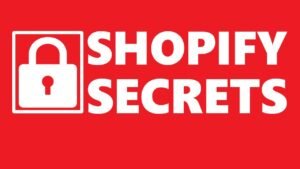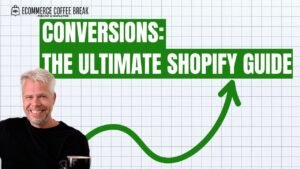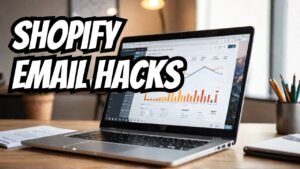Understanding the Shopify Marketing Ecosystem: An In-Depth Discussion with Brandon Amaroso
I’m surprised how many Shopify Merchants don’t have a strong grasp of what their customer retention looks like. Welcome to the e-commerce coffee break podcast! Today we discuss how to get a full grasp of the Shopify marketing ecosystem. Joining me on the show is Brandon Amaroso, founder and president at electricmarketing.com. So let’s dive right into it.
Hello and welcome to another episode of the e-commerce coffee break podcast. Today we want to talk about the Shopify marketing ecosystem and everything that comes with it. I will also touch on a couple of other topics that might be interesting to our listeners. Therefore, joining me on the show today is Brandon Amaroso. He’s the founder and president of electric.com—that’s electric with a Q at the end—a Shopify Plus certified agency. Brandon is an e-commerce strategist focused on customer retention and lifetime value with clients like Wine Insiders, Florence Bubbles, and Heal’s Aid. He is a Forbes 30 under 30 Alum and host of the D2Z podcast. Always good to have another podcast host on the show and author of “Think Z”. In 2022, Electric was acquired by Drinks, a top re-tech provider. We’ll dive into this for alcohol brands. So let’s welcome him to the show. Hi Brandon, how are you today?
Good, how are you? Thanks for having me, Brandon. Let’s dive into the Shopify marketing ecosystem. I think that’s something that specifically small and medium enterprises that are new to e-commerce are totally overwhelmed with. There are so many options; some parts are integrated into Shopify, while other parts like Meta ads, Google ads, retention come up, and so on. Give us a bit of an idea of what you understand as the Shopify marketing ecosystem.
Understanding the Shopify Marketing Ecosystem
Yeah, so I think it’s evolved a lot over the past five years. Shopify, you can kind of think of it like the Apple App Store in terms of just how many different apps there are that are downloadable and can plug into your existing interface and add some sort of additional features or functionality. These range from really small features all the way up to giant platforms that have raised hundreds of millions of dollars to build within the Shopify ecosystem. Three years ago, there was a movement towards best-in-class solutions and products. A Merchant’s tech stack could look like 25, 30, or even 35 apps. I went into some Shopify stores, and you would see 80 to 100 apps, which was far too much.
But that was three years ago. Now, what merchants are encountering, both those who are already within the Shopify ecosystem as well as the ones that are just migrating into Shopify or just getting started with e-commerce, is an environment where a lot of these companies have raised a significant amount of money and there’s only so far they can go with their current product offering. A lot of them are getting wider in terms of what they offer, moving more towards being a platform than just being a feature or a product that you would plug into your Shopify storefront. Some of our partners who just did SMS before now do email, reviews, loyalty, and subscriptions. It’s a consolidation.
Choosing the Right Tech Stack
With that, I think the selection process is much more critical because you’re choosing a provider that will sit across five different components of your website versus choosing an individual provider for each component. It’s a lot easier to hop from provider to provider when you’re just making one transition. If you’re using a solution for email, text, your loyalty program, your reviews, and subscriptions, that’s a lot within one platform, and unwinding that would be pretty painful. So I think the vetting and selection process needs to be extremely proficient and make sure that you exhaust all options. Long-term, being in fewer tools is better than having 50, 60, or 70 apps on your Shopify storefront for a variety of reasons.
Yeah, I couldn’t agree more. Obviously, Shopify just announced last week that there are now about 12,000 apps in the App Store. That made me smile because I say that’s completely, sorry for my French, [__]. It doesn’t really help anyone. Then you see the bigger apps that have been around for a long time, like Klaviyo, Yotpo, and LoyaltyLion, which have brought more and more features to their platform. It’s not really an app anymore; it’s a platform. When it comes to selecting the tech stack for a store, is the size or age of the brand a selection criterion for you, or where would you start picking the right apps for a brand?
Revenue and Growth Prospects
I would say age less so; it has more to do with the revenue they are generating through their online storefront. Especially when there are certain solutions that have a minimum platform fee associated with them, if you’re not making a significant amount of revenue on your e-commerce website, you’re not going to be signing up for some of these solutions that have that barrier to entry. A lot of the apps and platforms we use have more of a usage-based model. This allows for a smaller merchant to use the same product as some of the larger enterprises on Shopify. Those are typically our preference because a merchant can grow with the solution rather than having to use a second-rate or third-tier provider until they reach a point where they can transition to the better service offering. In a crowded marketplace with multiple providers for every feature and functionality you could want, we typically go towards the ones with a usage-based component. Whether it’s based on the total revenue generated, the number of orders, or the number of email contacts, it’s much better for us as an agency because we can deploy the same playbook with everyone versus giving smaller merchants a lesser experience. It really comes down to revenue and growth prospects. For some merchants who are really tight with their financials, we can dig into it with them in terms of what their tech stack budget can be and should be. But more often than not, it is really based on revenue.
Tech Stack Audits
Electric, as an agency, does audits when starting to work with a new customer. Four years ago, our audit was more about adding apps and additional features and functionality the merchant might or might not have. Now, merchants have way too much going on, and so it’s the reverse. You have 60 apps, but we can get you down to 20 because you’re not even using 10 of these. Also, you have four solutions provided by Rebuy or AfterShip, and you’ll not only save money but also have a better product that we can help deploy for you.
The tech stack is a big component because it can hinder a merchant’s ability to grow effectively. Beyond that, we dig into their on-site experience from a conversion rate standpoint. Do they have all the things in place for best practices for increasing AOV? On the flip side, we look at the retention experience. We place an order, whether it’s a one-time or subscription order, and we get all the emails and texts associated with both customer experiences. We dig in and analyze especially if we see in the data that there is a retention problem. There is more awareness of retention over the past year, but there’s still room for growth. Sometimes merchants don’t even understand that they might be acquiring customers cheaply in a certain ad channel, but it’s a leaky bucket, and only 20% are coming back and reordering. So, they should prioritize the channel that costs a little more to acquire the customer but has a higher repeat purchase rate and some are becoming subscription customers.
A big part of what we do is help tie together the disjointed handoff between a paid team and a retention team. Merchants are getting better at having those two teams work together versus a siloed environment. It helps a lot when you can show the data as well.
Retention Strategies
When it comes to retention strategies, our preferred channels are email marketing, SMS, and direct mail. Push notifications if they have an app, but those are usually the four main channels. Email has a higher frequency and volume because you’re not paying per email sent. Also, you have a little more leeway with a customer when it comes to how many times you email them. It’s not as personal as a text message, so opt-out rates are lower. Texts are intertwined within those flows, and some customers won’t be subscribed to SMS marketing. Some customers won’t even be subscribed to email marketing, making the transactional experience we create and deploy for them pretty important. We’ll have a separate transactional experience for customers who aren’t subscribed to email and SMS marketing. On the order tracking page, we’ll incentivize them to sign up for email and SMS marketing so we can communicate with them.
Direct Mail and Other Channels
Direct mail is something we’re testing a lot right now with holdout groups within some of these retention flows. Historically, we used it as a last-ditch effort, like if it’s been 90 plus days since an order, we’ll send something in the mail. Now, we’re thinking about it more proactively. For example, it’s been three weeks since an order, so we’ll send a replenishment reminder via direct mail. We’ll only send it to 50% of customers and target the other 50% with email, texts, and push notifications to see how that impacts the repeat purchase rate.
Those are the main channels. You also have advertising retargeting on your standard social channels, and some brands are leveraging connected TV and other things like that. But the tried and true retention channels are definitely email and SMS, with push and direct mail layered in.
The Challenges of Selling Alcohol Online
When it comes to selling alcohol and beverages online, the alcohol industry within the US is really complicated due to prohibition back in the 20s. When that was lifted, every state created its own rules and regulations around how alcohol could be transacted. You have states with very restrictive policies like Utah and Pennsylvania and very open states like California. Quite literally, all the way down to the zip code in each state, there are different rules. For example, there are certain dry counties in Texas where you can’t ship alcohol. It would be impossible to just spin up an online storefront on Shopify and start selling alcohol unless you want to go to jail. There are so many different rules and regulations within each state, like in Michigan, where you can’t ship above a certain amount of alcohol to an individual customer on a yearly basis. Drinks built out a rules engine that enables merchants to sell direct to consumers on the Shopify platform.
The flip side of that for non-alcohol merchants is giving them the ability to add alcohol as a category to their website. Alcohol is one of the most frequently requested add-on products from customers when they’re shopping online. It typically adds about 10% of additional GMV for a merchant. So, if they’re doing $100 million in topline revenue, they could be doing $110 million in topline revenue if they add alcohol. Businesses like Thrive Market, Misfits Market, and Macy’s offer a wine club or an alcohol offering on their website, all powered by Drinks. They don’t have to touch the product, do the sourcing, or the fulfillment; our system handles that for them.
Electric Marketing’s Role
Electric Marketing is really the in-house Shopify experts. We enable the rest of the Shopify ecosystem with education and materials around the alcohol opportunity. We’ll work closely with other agencies who have alcohol clients that want to migrate over to the Shopify and Drinks solution. We also step in where needed if there is a merchant that wants to migrate over to Shopify and they don’t have the in-house capabilities to do so or don’t already have an agency. We still have quite a bit of non-alcohol merchants that operate with our agency. It’s moving more towards a professional services organization that helps enable all of the customers of Drinks.
Onboarding and Pricing
For alcohol merchants who want to use Drinks’ tax and compliance solution for Shopify, they just download the app, add in a few details around their licensing, and they’re off and running. For larger merchants, it’s a more white-glove onboarding process due to more complex requirements. For adding alcohol to your storefront, it depends on your website setup and tech stack, but it typically takes about four to six weeks to iron out the contract details and ensure you’re good with the product selection. We have an AI solution that ingests all your customer and order data and then recommends the types of products you should be selling based on your customer demographics.
When it comes to pricing, if you want to add alcohol to your storefront, there’s a base platform fee depending on the size of the merchant and the type of program. For larger enterprises, there might be a branded program with branded packaging and products. For smaller merchants or those who want to test it out, you’ll pull from the assortment of supply we already have. Typically, we offer month-to-month contracts for smaller merchants and annual commitments for larger ones, but we’re relatively flexible at this point.
Final Thoughts
Unrelated to the alcohol side of things, I’m surprised how many Shopify merchants don’t have a strong grasp of what their customer retention looks like or what the customer journey looks like after the first order. At a bare minimum, download one of the apps that show your month-by-month cohort retention. Look at how likely customers are to come back and reorder based on the first product they purchased. Start digging into that. If you have a 25% returning customer rate and get that to 30% or 35%, it makes everything easier from a financial perspective and allows you to invest more in growth and customer acquisition. That’s the biggest takeaway I would stress.
Instead of chasing new clients and spending on Meta ads and other channels, work with what you already have. It’s easier to get more money out of an existing client.
For more information, you can visit drinks.com or reach out to us on LinkedIn. There’s also a contact form on our website, and one of our team members will get back to you the same day.
Thanks so much for your time today, Brandon. It’s been an insightful discussion on the Shopify marketing ecosystem and the opportunities within the alcohol market.
Read More: The 3 Email Strategies You REALLY Need for your Shopify store
Read More: The 3 Email Strategies You REALLY Need for your Shopify store



